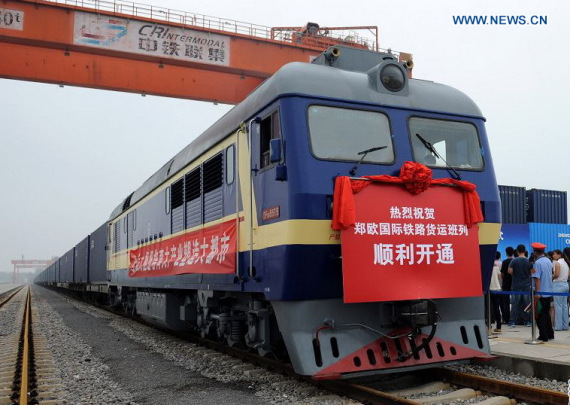
File photo taken on July 18, 2013 shows the first direct cargo train leaving from Zhengzhou to Europe at the railway container center in Zhengzhou, capital of central China's Henan Province. (Photo: Xinhua/Zhu Xiang)
After three years of development, the Belt and Road Initiative proposed by Chinese President Xi Jinping in 2013 has gradually and steadily brought change to peoples and countries along the ancient trade route, defying expectations of many international observers who have regarded it as a mere extension of Chinese diplomacy.
With more than 100 participants and advocates so far, including countries and international organizations, the initiative has now become a road to a happier life, their dreams and regional prosperity for local people along the route.
ROAD TO HAPPIER LIFE
As a master plan to integrate 65 countries from East Asia to Western Europe, China's Belt and Road Initiative is poised to improve the living standards of 4.4 billion people, more than half of the world's total population.
"No one knows what is waiting for us at the end of the road, but for all, I only wish the road will lead to happiness," Ma Yi, a Chinese construction worker working on roads in Laos, wrote on her blog.
As an employee of China's Yunnan Sunny Road & Bridge company, Ma has worked in this Southeast Asian country for five years and participated in several projects to improve Laos' infrastructure.
As Ma wishes, upgrading the No. 13 highway, the project conducted by her company, would bring the Lao people closer to a happier life.
The project, along with several other China-funded infrastructure projects in Laos, are part of cooperative programs within the framework of the initiative.
After the upgrade of the 81-km road, the travel time from Pakmong to Muang Xay will be shortened by over one hour. Villages along the road now have access to the power grid. Shops, restaurants, hotels and banks have been built, bringing more job opportunities for the local people.
With better roads, "we can plant more, earn more money and no longer have to worry that our produce may spoil in the fields before it ever makes it to the consumers," a local villager at Muang Xay surnamed Ketmane told Xinhua.
Infrastructure, an important aspect of cooperation under the initiative, not only brings faster transportation to the countries along the Belt and Road, but also offers them a chance to improve their technology.
"China is cutting-edge in the development of subway and railway transportation. It always has great things to share with Iran," said Siamak Ghasemi, a 36-year-old veteran worker in a Tehran-based factory under Tehran Wagon Manufacturing, a joint venture between Iran and China.
Sent to China twice for training, Ghasemi is quite aware of the technology transfer and localization of production in the process.
"At the very beginning, we imported from China; then we learned to assemble; now, with China's help, things are getting more localized that we have our own production line," Ghasemi told Xinhua.
ROAD TO DREAMS
For those who are actually involved in the projects under the framework, the initiative has been a road to their dreams.
When 30-year-old Nahla Emad decided to work in the China-Egypt Suez Economic and Trade Cooperation Zone (SETC Zone), she did not envision the decision would change her life.
The SETC Zone, established in 2009 with an initial area of 1.34 square km, is a landmark project of cooperation between China and Egypt under the Belt and Road Initiative.
"I was young with no experience in this kind of job when I joined the company, but now I am a manager of the marketing department," Emad said, adding that she had thought about such a promotion only in her dreams.
"Now everything at work is like a habit and the company is like my home. I live here, work here and built up my family here," she said.
The initiative allows participating countries to benefit from China's rapid growth. For people in Pakistan's Gwadar, the influence of the initiative is even more tremendous. It has transformed a fishing town into a prosperous port, realizing local people's dream that their port may become a second Dubai.
A town with a population of less than 100,000, Gwadar is blessed with a natural deep-water harbor that falls close to main shipping lanes and an anchor-shaped peninsula that shields the harbor from the waves of the Arabian Sea.
Though development plans had been drawn up by the Pakistani government in 2002, the town remained dormant for another decade before China chose the port as a major project in the China-Pakistan Economic Corridor, which is a major project of the initiative.
Land prices, a barometer that measures investor confidence, has more than doubled in the past two years, Gwadar Port Authority Chairman Dostain Jamaldini said.
Locals are constantly talking about Dubai when they picture their future, believing the huge opportunities created by China's Belt and Road Initiative will transform their fishing town and realize their dreams.
"What Dubai can achieve, so can we," Jamaldini said.


















































